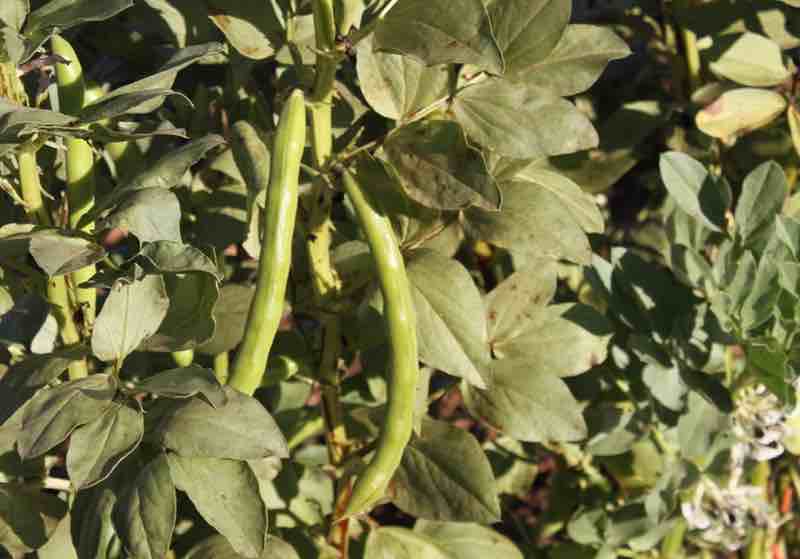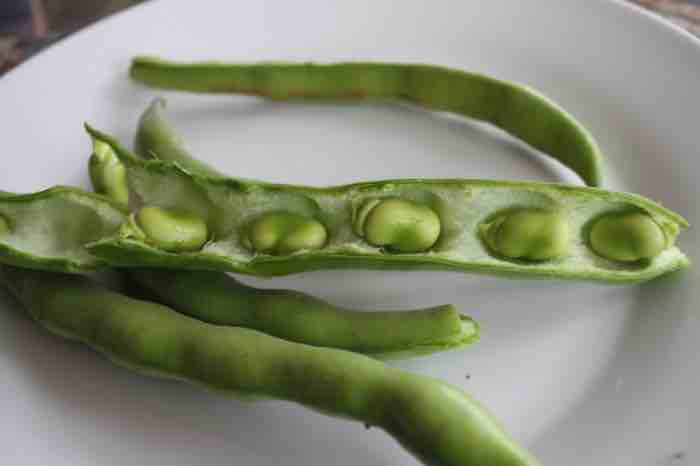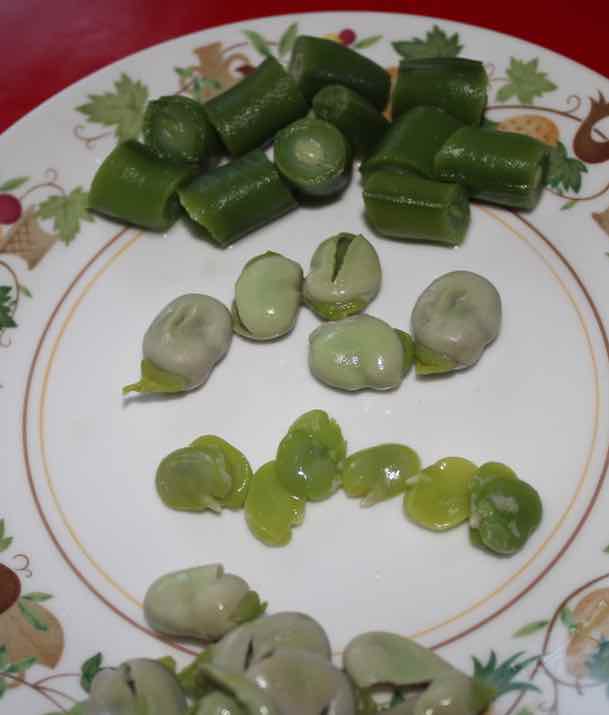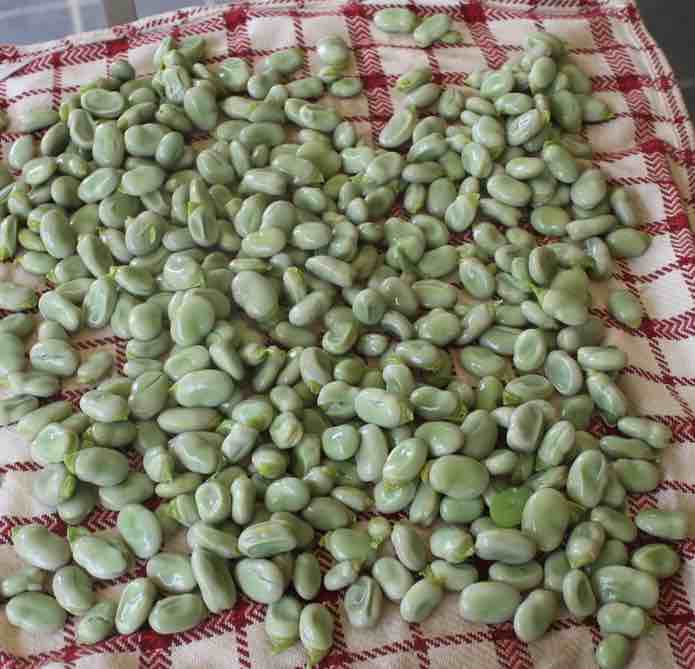- Bernard Preston homepage
- Broad beans
- The Nutritional Profile of Broad Beans
The nutritional profile of broad beans
The nutritional profile of broad beans is so complete; favas as they are also known are the only common source of L-dopa, the happy hormone. Why are we not all growing them?
Broad beans are perhaps the only legume that contains all the essential amino acids; and many more of the rest. They come from the Vicia faba plant.
Soybeans and chickpeas are next best but they lack methionine.
"Grain legumes" include beans, peas and lentils; and ground nuts. They are high in plant protein for those looking for greater wellness and more sustainable food sources.
Many people today are moving towards the so-called Flexitarian Diet; less animal protein.

The seeds are also often known as fava beans; thus some confusion exists. They are a very rich source of plant protein, second only to soyas; they are exceptional in that they contain all the essential amino acids.

The very young pods can be eaten whole. A pernicious, time consuming practice of "skinning" the seed coat is common; it contains much of the fibre, making the now-processed broad beans highly glycemic. They are thus unsuitable for diabetics and those who are obese.
 Once the seed coat is removed broad beans become highly glycemic.
Once the seed coat is removed broad beans become highly glycemic.The reason for this is that the plants and their pods very quickly become desiccated, starchy and chewy. The beans require abundant water and ideally should be eaten within hours of being harvested; they are best when grown in the home garden.
Amino acids
Amino acids are the building blocks of protein. There are 20 common different forms; they all contain nitrogen atoms, unlike starches and fats. They are able to do this by virtue of the Rhizobia bacteria that attach to their roots. They have the ability to harvest large amounts of the element from the atmosphere; 150kgNha-1.
Nine of these are known as "essential" amino acids. Humans cannot be healthy unless they consume all of them; the body is unable to synthesize them. Stunting of children will occur if any are deficient in the diet.
The nutritional profile of the broad bean is exceptional; it contains all nine essential amino acids including methionine, lysine and tryptophan. The mature seeds have about five times as much protein as those in the young pods.
All varieties contain around 25% protein.
Broad beans are particularly rich in lysine, an amino acid that is low in maize and wheat.
Trypsin inhibitors
Legumes in general contain an antinutrient known as a trypsin inhibitor which reduces the absorption of protein; and in certain vulnerable individuals may cause pancreatic enlargement. Soy is particularly high in this substance. The Sunrise variety of broad bean is especially low.
Trypsin inhibitors are deactivated by heating; raw broad beans could be problematic.
L-dopa
Broad beans are unique in another way. They are the only food that contains pharmaceutical amounts of L-dopa, a phenolic compound that is the precursor of a very important hormone in the body; low levels in the blood signal a serious neurodegenerative condition. It is called Parkinson's Disease.
Dopamine is normally produced by a nucleus in the brain. Mostly unknown environmental toxins, though a few have been named, target these cells. There is no cure. The only treatment is an exogenous supply of its precursor.
L-dopa can either be obtained from medication; or from daily consumption of broad beans.
The Fuego cultivar has the largest amount of L-dopa, and Sunrise one of the lower amounts; 5.0 vs 1.7[2].
 Drying blanched broad beans prior to freezing.
Drying blanched broad beans prior to freezing.The broad bean dilemma
Very young broad beans and especially their pods are the richest sources of L-dopa; however their protein content is low.
Mature beans contain far more protein but the L-dopa rich pods are inedible.
Thus it's best to enjoy both daily.
Minerals
Some cultivars of broad beans are particularly rich in iron and zinc but bioavailability may be negated by certain anti-nutrients such as lectins, trypsin inhibitor and phytates.
This is critical with around 20% of women in Western countries suffering from iron deficiency anaemia; the prevalence in South Africa is much the same. Researchers point out that a protein shift to a more sustainable plant-based diet could worsen the situation if the wrong cultivars are chosen.
The Sunrise variety has by far the greatest amount of both iron and zinc[2]; between 6 and 12 times more. It is also particularly low in phytate content giving the minerals the highest bioavailability index.
Fibre
All varieties of broad beans are particularly rich in fibre which humans cannot digest but instead are the main energy source for bacteria in the colon; the microbiome. The insoluble form is the most abundant, giving the stool bulk.
Lignans
Lignans belong to a group of compounds known as polyphenols; flavonoids are perhaps better known. They have a structure not dissimilar to human female oestrogen.
The richest sources are flax and sesame seeds but broad beans contain significant amounts. Their antioxidant properties contribute to preventing breast cancer and cardiovascular disease.
Haemolytic anaemia
It's important to note that 3% of people have a hereditary deficiency of the G6PD enzyme. They are prone to favism, an acute and potentially serious form of haemolytic anaemia. Two to three days after eating broad beans they may develop acute abdominal pain with destruction of red blood cells, dark urine and jaundice. This can lead to kidney failure.
The nutritional status and health of the individual are significant; for example, alcoholics are more prone to a severe reaction to favism.
The toxic "vicine" factor is located in the seed coat; those with this deficiency should skin the bean seeds. Traditional practices also include cooking at high temperatures and sprouting the beans to deal with the compounds that cause favism.
Male babies are particularly prone; it may also cross into the breast milk of lactating mothers.
The Emilia variety has by far the lowest levels of these toxic factors[2]. Sunrise is mid-range.
Take home
The "take home" from this summary of the nutritional profile of broad beans is that they are a great way for vegetarians to get more protein. However since they are more vulnerable to iron deficiency anaemia the right cultivars need to be chosen; those that are low in antinutrients. The Sunrise seems a good choice.
For those wanting the L-dopa for treatment of Parkinson's Disease, the Fuego cultivar would be a better choice.
And finally everyone eating broad beans for the first time, it would be advisable to begin with a very small helping; and look out for any sign of abdominal pain or jaundice over the next few days. Favism is a serious problem for a small group of people; you could be one.
The nutritional profile of broad beans
The nutritional profile of broad beans considers all the amino acids in this legume.
When browsing use right click and "Open Link in New Tab" or you may get a bad gateway signal.
Newsletter
Our newsletter is entitled "create a cyan zone" at your home, preserving both yourself and Mother Earth for future generations; and the family too, of course. We promise not to spam you with daily emails promoting various products. You may get an occasional nudge to buy one of my books.
Here are the back issues.
- Lifestyle and ideal body weight
- What are ultra-processed foods?
- Investing in long-term health
- Diseases from plastic exposure
- Intensive lifestyle management for obesity has limited value
- A world largely devoid of Parkinson's Disease
- The impact of friendly bacteria in the tum on the prevention of cancer
- There's a hole in the bucket
- Everyone is talking about weight loss drugs
- Pull the sweet tooth
- If you suffer from heartburn plant a susu
- Refined maize meal and stunting
- Should agriculture and industry get priority for water and electricity?
- Nature is calling
- Mill your own flour
- Bake your own sourdough bread
- Microplastics from our water
- Alternative types of water storage
- Wear your clothes out
- Comfort foods
- Create a bee-friendly environment
- Go to bed slightly hungry
- Keep bees
- Blue zone folk are religious
- Reduce plastic waste
- Family is important
- What can go in compost?
- Grow broad beans for longevity
- Harvest and store sunshine
- Blue zone exercise
- Harvest and store your rainwater
- Create a cyan zone at your home
Did you find this page interesting? How about forwarding it to a friendly book or food junkie? Better still, a social media tick would help.
- Bernard Preston homepage
- Broad beans
- The Nutritional Profile of Broad Beans
Address:
56 Groenekloof Rd,
Hilton, KZN
South Africa
Website:
https://www.bernard-preston.com